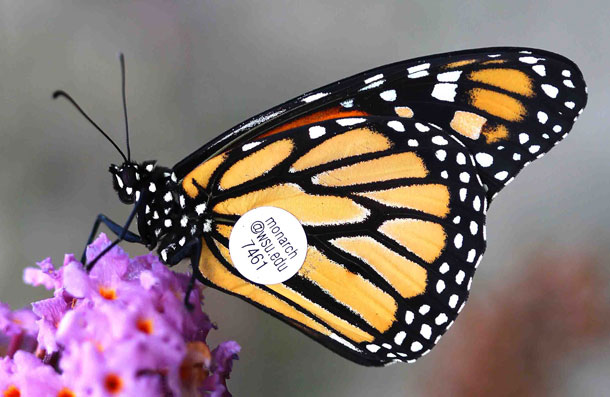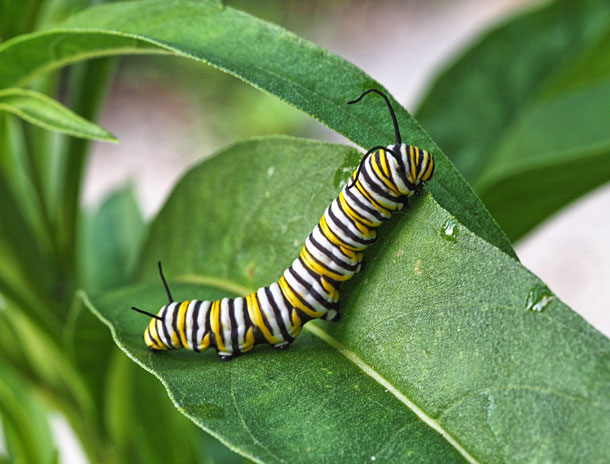How to Raise Monarchs
Air Date: Week of July 26, 2019

To keep track of Monarch Butterflies’ migratory paths, groups like the Monarch Watch tag the butterflies. (Photo: USFWS - Pacific Region, Flickr, CC BY-NC 2.0)
Some people have fond memories of raising monarch caterpillars in their childhood classrooms and homes. But a recent study found that some captive-bred monarch butterflies the US are at a disadvantage when completing their migration to Mexico. Monarch Watch Director Chip Taylor joined Host Bobby Bascomb to share some tips for raising monarchs that won’t be led astray in their migration.
Transcript
BASCOMB: It’s Living on Earth, I’m Bobby Bascomb.
Each spring, Eastern monarch butterflies wake up in the mountains of Mexico and make their migration to warmer climates, like Texas, where they breed and die. The Texas monarchs travel a few hundred miles further north, where they also breed and die. It takes four or five generations of monarchs to reach the northern end of its range, perhaps as far north as Canada, where a super generation is born that will fly all the way back to the same mountain in Mexico where its great, great, great grandparent started the journey. Scientists don’t understand how the monarch completes its incredible voyage, but a new study has found some well-meaning butterfly enthusiasts may be hampering it. That study from the University of Chicago finds that captive-bred monarchs are not as likely to complete that return migration to Mexico. Here to tell us more is Chip Taylor, Director of Monarch Watch. He says the study should really be used to inform us about the best way to raise monarchs at home.
TAYLOR: So, the general takeaway message that many people have had from this paper is that reared butterflies don't migrate. And, that's simply not true. What you do have to do to get monarchs that migrate is rear them under the right conditions. And, that's something that has not been standardized. Many people are rearing them under conditions that are not entirely satisfactory, and the reared butterflies tend to be a little bit smaller. So, their possibility of getting to Mexico is a little bit reduced. And, a lot of the butterflies that are reared, are reared in parts of the US where the probability of getting to Mexico is actually reduced as well, simply due to the distance. So, the reared butterflies don't get to Mexico as well as the wild ones do, but they still get there.
BASCOMB: So, is the take home message here, then, if somebody is interested in raising caterpillars in their own home, don't buy them online from one of these breeders, but go out and look in your yard and your neighborhood?
TAYLOR: Most of the people that are doing the backyard rearing are rearing monarchs that they find in their backyard. Or they're scouring the landscape to find eggs, and they're going to parks, and they're going to natural areas and finding eggs and bringing them in. And the reason they're doing this is they're invested in something we call monarch rescue, which is the idea that about 98% of all of the eggs laid out there never become an adult butterflies. And, you know, they're subject to all sorts of predation, and parasitism, and so on and so forth. And so, if you bring them in, you'll be adding to the population. Well, you will, if you do it right. But, if you don't do it right, you're not going to be adding to the population. And so, what we're trying to do is encourage people to do the right thing. Rear these butterflies in the way that they have some prospect of not only getting to Mexico, but surviving the winter, and surviving the trip back north to Texas, and surviving to reproduce.
BASCOMB: And, so, what are the things that people should be doing if you're going to raise them in your home?
TAYLOR: What we really advise people to do is raise them on naturally occurring plants or plants in pots. To rear them with their normal day-night exposure. To rear with normal photoperiod exposure; to do this, and to do it well so the butterflies achieve maximum size. And also, tag them and release them at the right time, which is at the beginning of the migration. So, it's relatively simple, if you're gonna do it in a school or in a kitchen or something like that, expose them to natural light. But hopefully keep them in a place where they can experience day-night temperature variation as well.

A monarch butterfly. (Photo: Peter Miller, Flickr, CC BY-NC-ND 2.0)
BASCOMB: Would the ideal scenario be to put them in a jar or a net or something on a porch, maybe a screened-in porch or something where they're getting the day and the night and the temperature changes?
TAYLOR: That would be a good way to do it. And probably not in a jar, but everything from an aquarium to a cage. And you can use cut leaves or live plants. But, if you're going to use cut leaves, they've got to be really fresh, and you've got to change out the leaves, you know, and keep the containers clean, and so on and so forth. This is not a hard thing to do. And it's kind of fun to do. I've been doing it since I've been a kid. [LAUGH] I've really been doing this for a very long time. It's a very enjoyable activity. We don't want to discourage people from doing it. But we'd like to have people do it in the best possible way.
BASCOMB: I have to admit; I have ulterior motives for asking you all these specific questions. I raised them last year in my home with my daughter, just for her to have that experience of seeing how they change and grow, and talk about the metamorphosis and the science behind it. If I want to do that again this year and tag them, how would I go about doing that? How does the average person know how to tag a butterfly? Seems like a very, I don't know, fine skill? [LAUGHS]
TAYLOR: [LAUGHS] Well, we have instructions on our website, we have a tagging program we've been running since 1992. Monarchs are pretty sturdy butterflies, and we teach people to put the tag on the discal cell, which is a large palm-shaped cell on the underside of the hind wing. It's a tag that weighs about a fiftieth of the mass of the butterfly. And, every tag has a different code. And we take that information, and we enter it into a database. And then when there is a recovery, we can trace back to who tagged that particular butterfly. But furthermore, when you send in your data sheet, we can use all of the data for every tagged butterfly as a way of tracking this migration, to see whether migration is early, whether it's late, and so on and so forth. And by putting all that information together, we can take a look at whether butterflies tagged in Massachusetts have the same possibility of getting to Mexico as, say, the butterflies tagged in Buffalo, New York.

The preferred food of Monarch caterpillars is native milkweed. (Photo: John Brandauer, Flickr, CC BY-NC-ND 2.0)
BASCOMB: And, before you go, why do you do this work? Why have you dedicated your life to monarchs as opposed to doing any number of other things you could have done? Why are monarchs important for anyone?
TAYLOR: The quickest answer is to save the planet. [LAUGHS] We have to save this planet. And with regard to monarch butterflies, it's connecting people with things they value. That's an important thing. And monarch butterflies are valued by a lot of people. They're recognized as a symbolic organism that tells us a lot about what's happening in the environment. And, you know, if we can connect with something that's of value that will probably be lost, then maybe we can get people's attention.
BASCOMB: Chip Taylor is Director of the Monarch Watch. Chip, thanks for taking the time with me.
TAYLOR: Well, thank you! Appreciated being on.
Links
Monarch Watch’s guide to tagging and rearing monarch butterflies
Living on Earth wants to hear from you!
Living on Earth
62 Calef Highway, Suite 212
Lee, NH 03861
Telephone: 617-287-4121
E-mail: comments@loe.org
Newsletter [Click here]
Donate to Living on Earth!
Living on Earth is an independent media program and relies entirely on contributions from listeners and institutions supporting public service. Please donate now to preserve an independent environmental voice.
NewsletterLiving on Earth offers a weekly delivery of the show's rundown to your mailbox. Sign up for our newsletter today!
 Sailors For The Sea: Be the change you want to sea.
Sailors For The Sea: Be the change you want to sea.
 The Grantham Foundation for the Protection of the Environment: Committed to protecting and improving the health of the global environment.
The Grantham Foundation for the Protection of the Environment: Committed to protecting and improving the health of the global environment.
 Contribute to Living on Earth and receive, as our gift to you, an archival print of one of Mark Seth Lender's extraordinary wildlife photographs. Follow the link to see Mark's current collection of photographs.
Contribute to Living on Earth and receive, as our gift to you, an archival print of one of Mark Seth Lender's extraordinary wildlife photographs. Follow the link to see Mark's current collection of photographs.
 Buy a signed copy of Mark Seth Lender's book Smeagull the Seagull & support Living on Earth
Buy a signed copy of Mark Seth Lender's book Smeagull the Seagull & support Living on Earth

